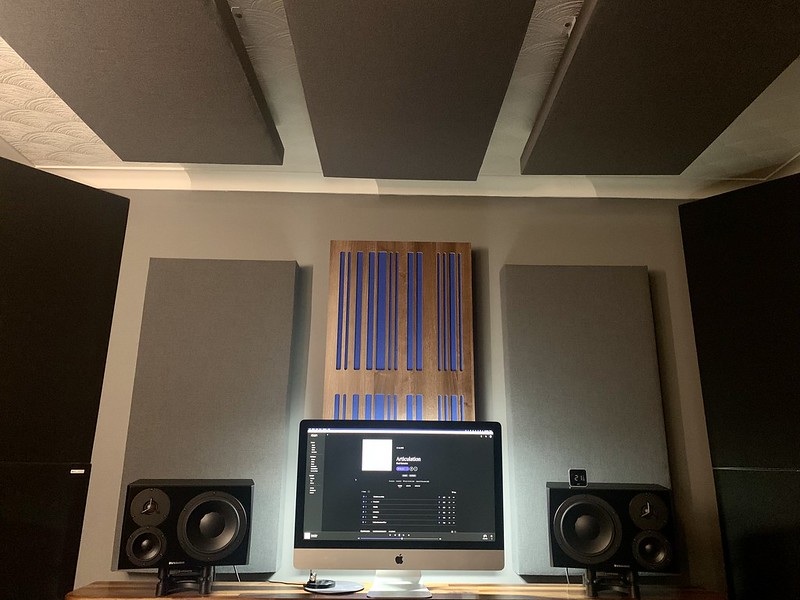tuga
Major Contributor
So today the panels are back up and I'm a very happy bunny today.
Ha, but were you wearing a blindfold when AB-testing?
And I hope you listened to a single speaker placed in front of your iMac...
So today the panels are back up and I'm a very happy bunny today.
You didn't say that directly, but only to make sure: one (!) frequency cannot logically decay ;-)I'm not sure I understand what you said by there is no 'decay' of a single frequency ?
RT60 and T60 are 2D graphs of time vs frequency (that can be more or less smoothed).
I closed my eyes, this'll do won't it?Ha, but were you wearing a blindfold when AB-testing?
And I hope you listened to a single speaker placed in front of your iMac...

I think having been attending more symphonic concerts lately and listening to more recordings, I'm only at the point where I'd be happy if I can confirm that the conductor put the violas on the left with the violins or on the right with the cellosJust like you I pay attention to imaging when listening do live acoustic music. I certainly hear imaging (and I've always tended to favor the closer seats at symphonies).
Is it "pin point?" That can be hard to agree upon because it's pretty subjective what we might mean by "pin point," as in how precise does it have to be for any particular individual to think "this is pin-point imaging!"
Where I live, in a downtown-adjacent area, there is almost constant live music being played in the streets - usually small folk or jazz groups, live un-amplified instruments. When I stop, close my eyes and listen for imaging it's actually pretty close to plenty of small group recordings I play on my system.
I would say that the live imaging is actually quite precise - I can point to exactly where the trombone player is and that he is several feet in front of the drums etc.
It would be if music had standards for tonality. Then we could replicate it and be done. Right now, we have no idea how music is mixed, what the tonality of the room was where the music was created, etc. So this problem has no specific solution. Just listening to a different set of music will get you to potentially prefer something else. All we can do is get better than random guess.Fair enough. What I meant is that the preference should be universally applicable.
Either way, you best not chop off a key heading in what you quoted. You also didn't answer me. Do you own the book or ran with that abstract from someone else's post?You seem to be changing between control room and domestic room indiscriminately, it’s hard to follow
You haven't been able to poke any holes so I don't know why you say it is easy. If it were easy, you would be putting forward myriad of research he shows to back his point of view. For your part, you just disagree.It’s just as easy to point out flaws in Toole’s research
That's just wrong. There is nothing natural about sound coming out of a point source of a speaker. Side reflections pull the image of the sound out of the point source of the speaker, giving a more proper presentation. People who prefer this are not stupid. They like what they hear for this reason. Your impression of why this is wrong continues from the lay confusion there must be a lot of reverb, echoes, etc. As Dr. Toole shows, side walls cannot produce sufficient envelopment anyway. For that, you need multichannel and hence his affinity there.The envelopment of the concert hall is either captured or enhanced in the mix.
You can’t conflate recorded envelopment with room-generated envelopment.
To my eyes this is an area where Toole’s personal preference has stood in the way of unbiased interpretation.
He’s fond of envelopment to the point of using upmixing
I own the book.Either way, you best not chop off a key heading in what you quoted. You also didn't answer me. Do you own the book or ran with that abstract from someone else's post?
Can you give some example tracks with ambience..?

Thanks for trying but you have a near-field situation with no side-wall treatments for first reflection points which is the topic of discussion here. This kind of experiment is tricky because removing absorbers also changes the rooms overall level of reverberation so it is not a proper AB test. You are also doing the test sighted which makes it harder. The research I post already about mixing music dealt with both of these factors by keeping the overall level of absorption the same and keeping the testing blind.I tried a totally unscientific and subjective experiment yesterday by removing the side wall absorption at first reflection points, and removing the sidewall absorption/diffusion just behind me whilst leaving front/rear of room as is. (I didn't remove them personally, got my rather bemused mum to remove them for the afternoon)
Just so we're absolutely clear I have absolutely zero/zilch/nada/not a fu£king jot of acoustic training so this purely based on what I heard, the room was set up a few years ago by a mate who works in the industry using rew/umik mic and his 30+ years of work in studios)
Front of room
4 tri traps with membrane range limiter, 2 4" absorption panels with tuned membrane and 1 4" absorption/diffusion


3 2" panels on ceiling
Rear of room
Rear of room with 8" bass traps with tuned membrane and 4" absorption/diffusion

I removed the 4 side wall panels shown below (old pic, ignore my previous krk's, these are all old pics)


I sat and browsed my usual listening of electronic/electronica such as Jon Hopkins, Craven Faults, Underworld, Moby, Carl Craig, Rival Consoles, Chemical Brothers, Daft Punk, Dave Clark, Loscil etc...etc.
The sound in listening position in front of monitors was undefined, less direct snap, less impact and the side wall reflections were rather annoying for my preferred musical choice.
So today the panels are back up and I'm a very happy bunny today.
This concludes my totally unscientific subjective appreciation of how my room sounds with/without side wall treatment
Pull the image of the sound? Sorry, I don't understand what you mean.That's just wrong. There is nothing natural about sound coming out of a point source of a speaker. Side reflections pull the image of the sound out of the point source of the speaker, giving a more proper presentation. People who prefer this are not stupid. They like what they hear for this reason. Your impression of why this is wrong continues from the lay confusion there must be a lot of reverb, echoes, etc. As Dr. Toole shows, side walls cannot produce sufficient envelopment anyway. For that, you need multichannel and hence his affinity there.

well stated, but just a side note, I noticed Dr. Toole's book is up to $60 on Amazon...Sadly the folklore has gotten so bad that if you don't have a room full of acoustic panels, folks think something wrong with your room. What is really wrong is that people haven't spend $35 on Dr. Toole's book and a few days of reading and learning about real sound acoustics. Please, please do not follow the Internet consensus on this. They are just wrong.
There you go: you don't even know the standard terminology about the topic we are talking about. It is also described at length in the Acoustics of Small Rooms which you just claim to own. Spend more time reading the research and less complaining and we will make progress.Pull the image of the sound? Sorry, I don't understand what you mean.
Thanks. I could swear when the original edition came out it was that cheap. But I see it at $56 for electronic version which is what I recommend (much easier to search).well stated, but just a side note, I noticed Dr. Toole's book is up to $60 on Amazon...
The way I understood it, the listeners in Toole’s tests preferred speakers with even directivity if set up in a reflective room, that doesn’t infer that they preferred a reflective room.Again, it is not his preference, it is that of majority of listeners when formally tested. To advocate otherwise means pretending that the preference of a few is what should be advocated.
No, that is not the case. Research is independent for each topic. But each does play on the other. FYI there was another research done with speakers with bad directivity and even there, side reflections were thought to be good. I don't recall the paper title so can't find it now.The way I understood it, the listeners in Toole’s tests preferred speakers with even directivity if set up in a reflective room, that doesn’t infer that they preferred a reflective room.
good point about searchability. My fondness for physical objects gets in the way in this case where the book is really a reference document and digital tools just work so much better than things like a human-made index.Thanks. I could swear when the original edition came out it was that cheap. But I see it at $56 for electronic version which is what I recommend (much easier to search).
Index, A History of the: A Bookish Adventure from Medieval Manuscripts to the Digital Age by Dennis Duncan is an interesting read.good point about searchability. My fondness for physical objects gets in the way in this case where the book is really a reference document and digital tools just work so much better than things like a human-made index.
